ISS: Prichal
Non-EO
Quick facts
Overview
| Mission type | Non-EO |
| Launch date | 24 Nov 2021 |
Prichal Node (Docking Module on the Russian Segment of the ISS)
Launch Preparations Launch References
The Prichal Node Module, UM, was designed for the Russian Segment of the International Space Station, but potentially, it could also serve as a hub of the future new station. The Prichal was intended to be attached to the MLM Nauka module, providing five extra docking ports to the Russian Segment and giving a potentially unlimited life span to the future outpost. 1)
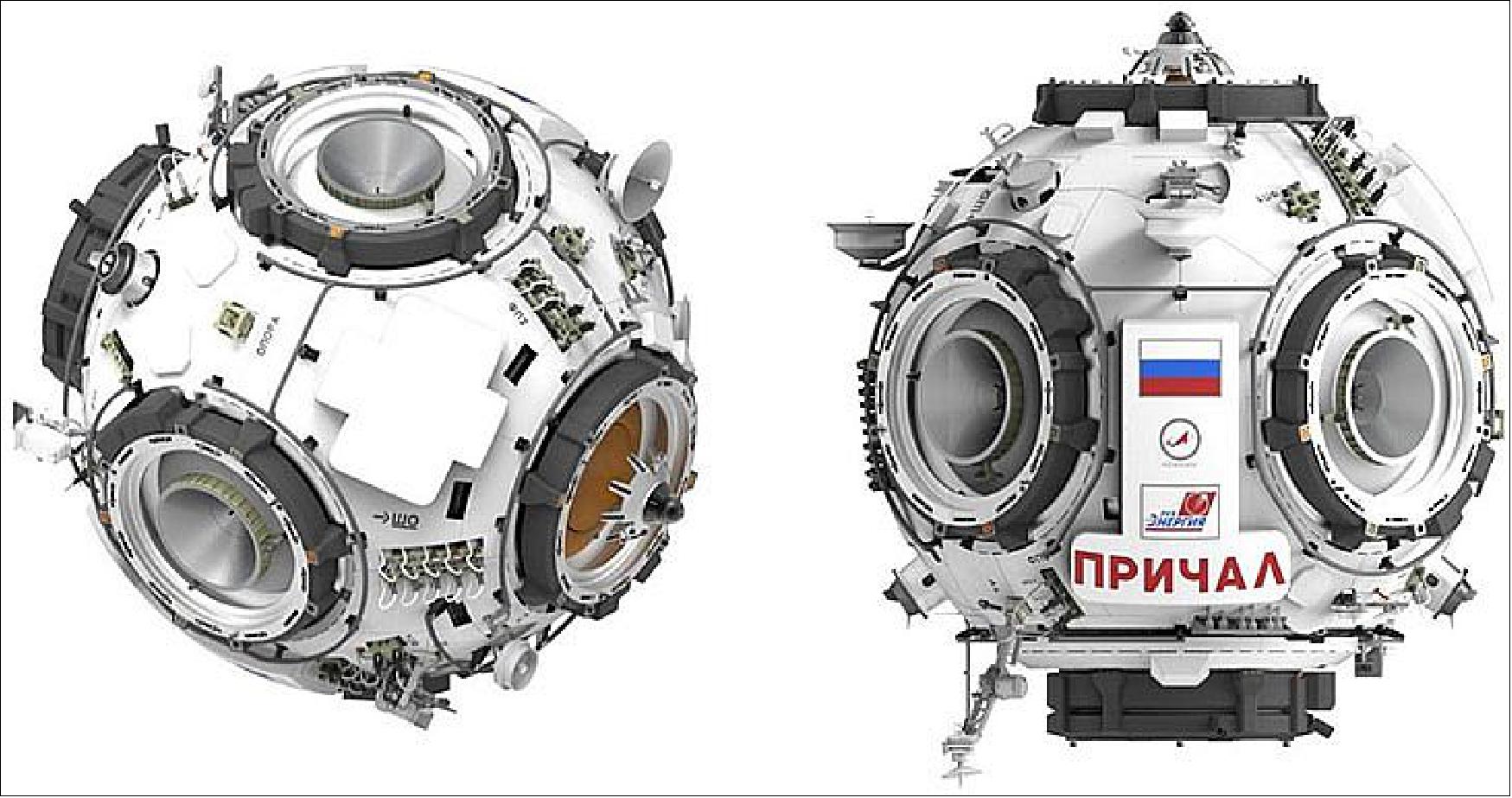
Liftoff mass (with Progress-MS space tug) | 7,290 kg |
In-orbit mass | 4,000 kg |
Cargo to be delivered with the module | 1,000 kg |
Number of docking ports | 5 |
Launch vehicle | Soyuz-2-1b (14S54) |
Payload fairing | 81 KS-UM 1000-0 No. T 15000-001 |
Launch date (planned) | 24 November 2021 |
Docking date | 26 November 2021 |
Launch site | Baikonur, Site 31, Pad 6 |
Destination | ISS, Russian Segment, MLM's nadir port (Insider Content) |
Background
In the mid-2000s, financial problems forced the to redesign its segment of the International Space Station, ISS. After considering various options, engineers at RKK Energia, the nation's prime contractor in the ISS project, proposed to add a new element called "Uzlovoi Modul," UM for short, or Node Module in English. The spacecraft was later dubbed Prichal - a Russian for "pier."
In early 2010s, The Prichal Node Module went from the drawing board to factory assembly in just a couple of years, but then the unique spacecraft remained stuck on the ground for the rest of the decade due to the domino effect of delays from the troubled Nauka module.
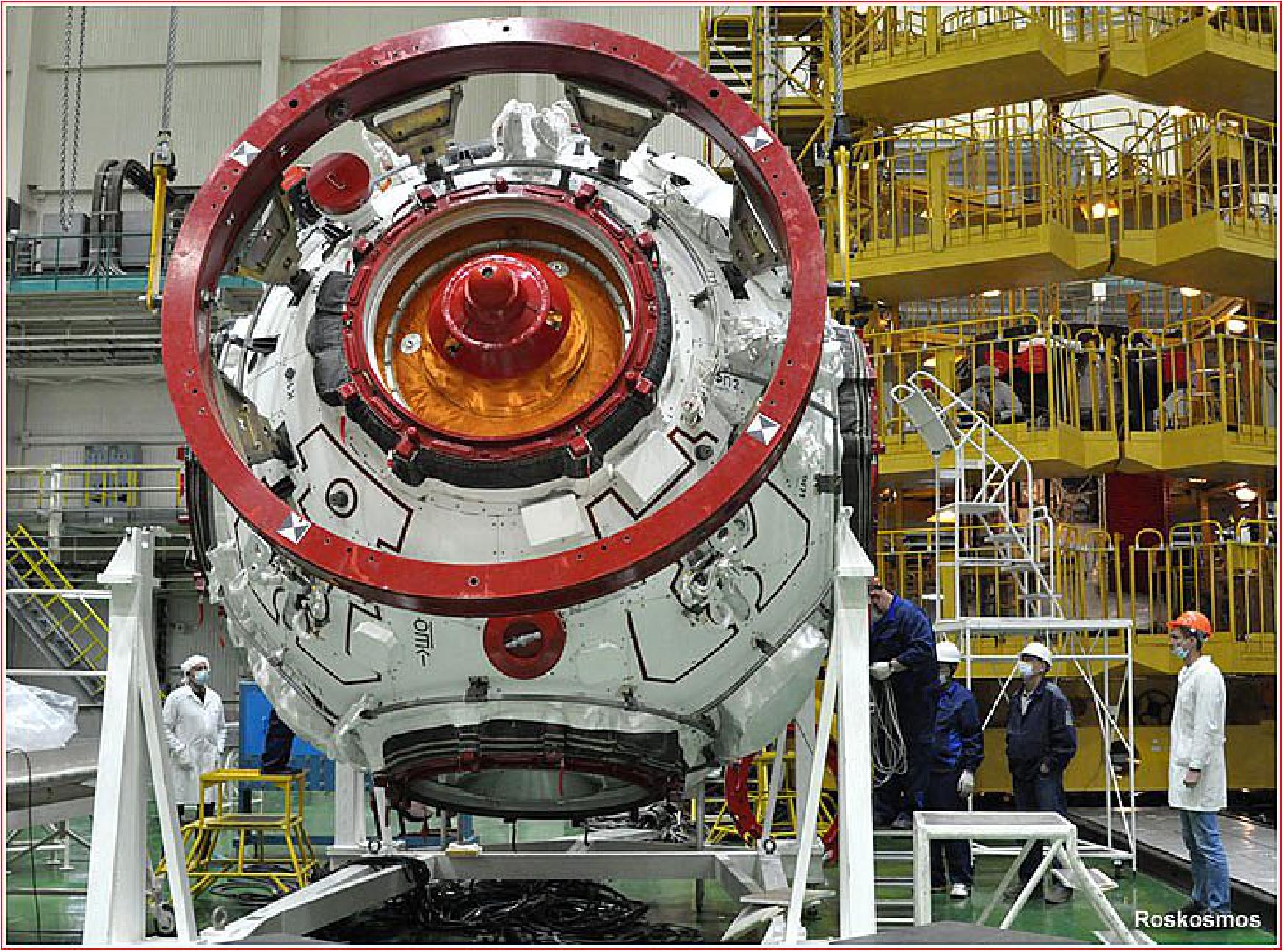
Prichal's Flight Profile
The Prichal and its cargo ship will be launched in a single stack on a standard Soyuz-2 rocket from Baikonur.
For its ride from the initial parking orbit, where it will be released by the launch vehicle, to the ISS, the Prichal Node Module will be integrated with a custom version of the Progress cargo ship (Development Model No. 11F615, Series 400). For this mission, the usual dry cargo and refueling section on the cargo ship will be replaced with a custom-built adapter, PPr, providing separation interface between the module and its space tug. That particular arrangement had been successfully used for the delivery of the Pirs Docking Compartment, SO1, and Poisk Mini-Research Module, MIM2, to the ISS.
However, due to oversized diameter of the module, it was to be protected with a 81KS payload fairing, which is wider than standard payload shrouds used in Progress missions. A new transfer ring, PKhO-PG, was also required to connect the space tug and the upper adapter, PKhO, of the third stage.
The Progress will use its own propulsion and flight control system to deliver and then permanently attach the Node Module to the nadir (Earth-facing) docking port of the MLM module on the Russian Segment of the ISS. During its trip to the station, the node module will also make a one-time delivery of 1,000 kg of cargo.
Following the arrival at the ISS, the Progress space tug will be undocked from Prichal along with the PPr adapter and deorbited over the Pacific Ocean. The undocking of the space tug will open the access to the passive docking port along the Prichal's +X axis.
New Launch Date Set for the Node Module
In the first half of 2020, the launch of the MLM Nauka module to the International Space Station, ISS, was shifted to the middle of the second quarter of 2021. In turn, the follow-on UM Prichal module was set to fly in the middle of the third quarter of the same year, or between three and four months after the Nauka.
In a provisional ISS flight manifest drafted by Roskosmos at the end of Summer 2020, the launch of Prichal was penciled for September 6, 2021, with the docking to Nauka's nadir port two days later.
At least three spacewalks aboard the Russian Segment of the ISS were expected to take place during a time period between the launches of Nauka and Prichal and one more sortie was planned soon after the arrival of the Prichal at the station. Russian cosmonauts would then make another trip to the exterior of the station in the early fourth quarter of 2021, followed by a series of six spacewalks at the end of 2021 and the beginning of 2022. This work should complete the integration of the two new spacecraft into the Russian Segment.
By the end of Fall 2020, the launch of Prichal slipped to November 24, 2021. By early November 2021, Prichal's instantaneous launch window was narrowed down to 16:06:32 Moscow Time. The launch vehicle was expected to insert the Progress M-UM/Prichal UM stack into a 193 by 240-kilometer orbit.
If Prichal reached its orbit as planned, the undocking of the Progress MS-17 spacecraft to free the nadir port of the Nauka module would take place on Nov. 25, 2021, at 14:18 Moscow Time.
The stage would then be set for the fully automated docking of Prichal to Nauka on November 26, 2021, at 18:25 Moscow Time, following a standard two-day rendezvous profile with the station practiced during routine Progress resupply missions.
At the time of final approach at altitude of around 460 km, the ISS crew would be operating the TORU manual control rendezvous system in a standby mode in case of any problems with the Kurs-NA automated system.
The propellant supplies aboard the Progress M-UM spacecraft should enable the second rendezvous attempt with the station, while reserving a cache for the subsequent deorbiting of the PAO module.
As of November 2021, the separation of the aggregate compartment, PAO, of the Progress M-UM space tug from Prichal was scheduled for Dec. 22, 2021, at 01:20 Moscow Time. The PAO module would deorbited three orbits after separation from Prichal.
Prichal Launch Campaign
On July 31, 2021, the Prichal and its Progress M-UM space tug were shipped to Baikonur by rail, after completion of joint tests with the simulators of the Nauka and the Zvezda modules, according to Roskosmos. The shipment to Baikonur also took place immediately after the docking of the Nauka module with the ISS. On August 9, 2021, Roskosmos confirmed that Prichal had arrived at Baikonur and on the morning of August 11, the joint Prichal/Progress M-UM stack was unloaded inside the spacecraft processing building at Site 254.
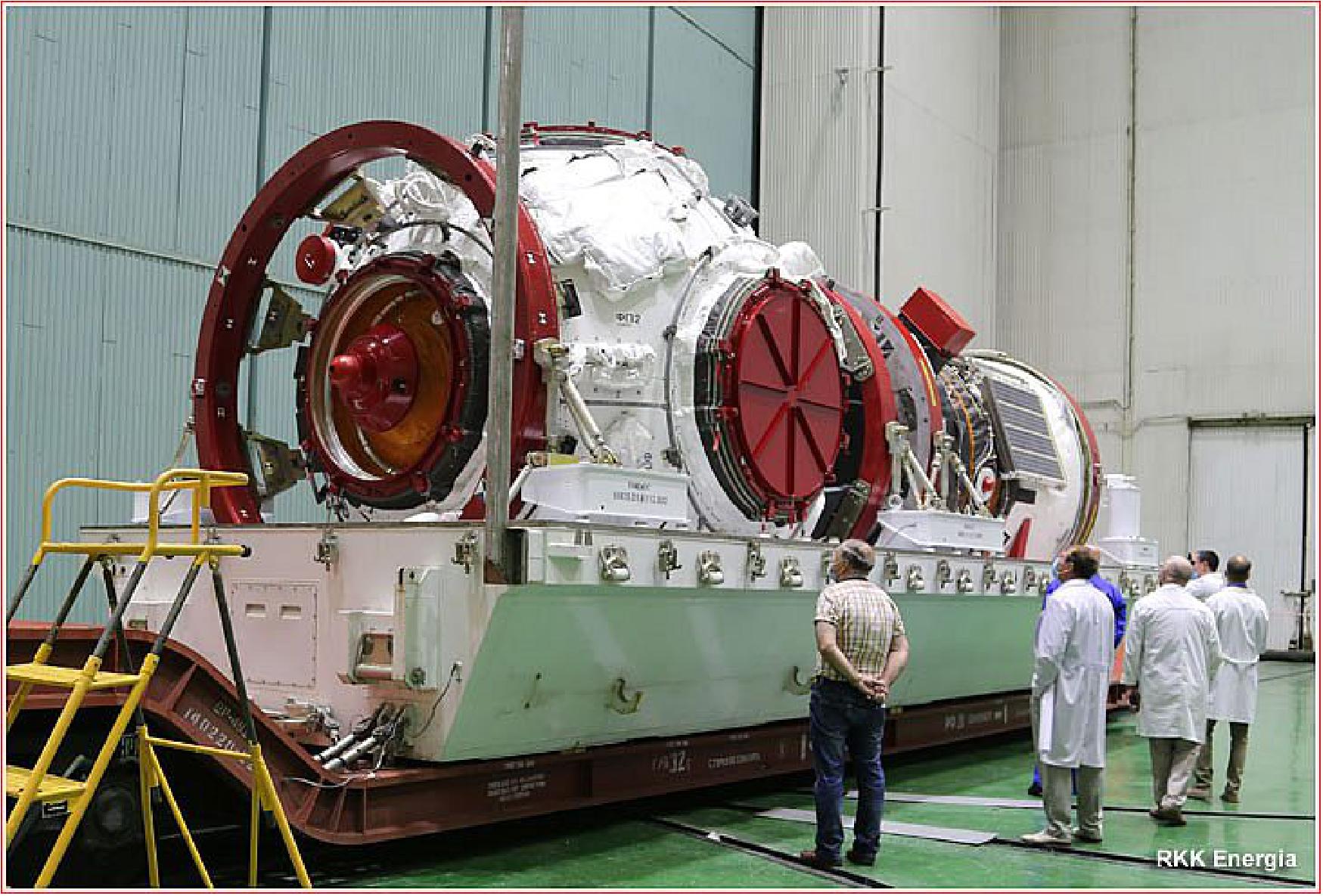
On the same day, specialists from RKK Energia installed the module and its space tug in their respective processing rigs at Hall 104 and began setting up the automated test network of the processing complex. As part of entry certification process, specialists conducted visual inspection of the Instrument Compartment, PAO, of the space tug and performed testing of the solar panel deployment mechanism on the Progress M-UM vehicle, RKK Energia said.
In the meantime, the Soyuz-2.1b launch vehicle for the mission arrived at Baikonur on August 18 and was unloaded inside processing facility at Site 112 on August 24, 2021. The components were then expected to be moved to the processing building at Site 31, where they would undergo assembly.
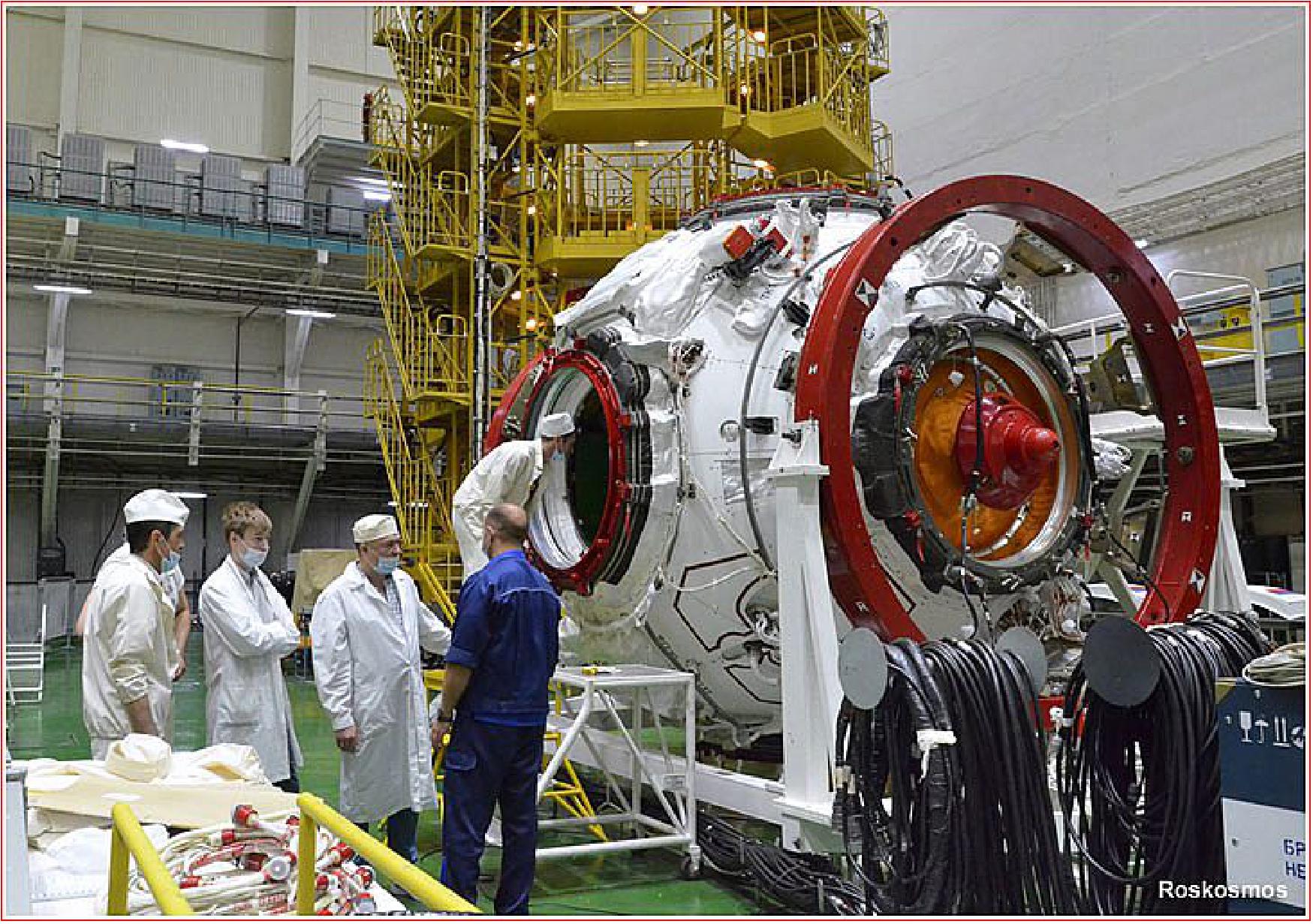
In the meantime, after the formal entry control procedure, the testing of Prichal officially started on August 28. Specialists from RKK Energia assembled ground testing equipment and cable network for autonomous electrical checks of the module, which was installed at the integrated test stand at Hall 104 of the processing building at Site 254.
In the following weeks, specialists conducted electric tests and functional tests of transit propellant lines (designed to deliver fuel and oxidizer from cargo ships to other modules of the Russian ISS Segment.)
On Sept. 20, 2021, Prichal was transferred into the 17T523MR vacuum chamber for a two-day air-leak testing of its pressurized hull. In parallel, electric tests started on the Progress M-UM space tug vehicle for the Prichal module at its work site. The trials included powering up equipment for flight control and navigation, telemetry and communications, attitude control and orbit tracking, thermal control and propulsion, Roskosmos said. The module was back at its work site by September 23.
Prichal Meets its Space Tug
By early October 2021, Prichal underwent tests of onboard automatic systems and the launch readiness simulation using ground diagnostics equipment. On October 4, the module was lifted from its work site and transferred to the processing rig of the Progress M-UM space tug, where it was connected to the adapter of the aggregate module, PAO, of the Progress with mechanical locks. Further integration activities included connections and tests of power, command and data interfaces between the module and the space tug.
On October 11, specialists began powering up the module's onboard systems and bringing them to launch readiness using ground testing equipment. The module and its space tug were then lowered in horizontal position and moved into the anechoic zone, where tests of the spacecraft's Kurs-NA radio system began on October 20. On October 28, Roskosmos announced that vacuum tests had been successfully completed.
On November 5, specialists conducted tests of solar panels aboard Progress space tug by exposing them to an array of electric lights. At the same time, the preparation of cargo items slated for delivery to the station aboard Prichal was in final stages, according to Roskosmos. These operations including loading of around 700 kilograms of cargo for the 66th long-duration expedition aboard the station, including food, personal protective equipment, water filters, repair hardware, hygiene and medical supplies.
On November 10, a meeting of technical management in Baikonur cleared the Progress M-UM space tug with the Prichal module for irreversible operations, including fueling and loading of pressurized gases.
On November 12, Roskosmos announced that a three-day process of pneumatic testing on all boosters comprising the Soyuz-2-1b rocket for the Prichal mission had been completed. By that time, specialists were setting up (another) round of tests, checking onboard system for monitoring propellant loading levels and conducting autonomous tests of the measurement system.
By November 13, fueling operations with Prichal were completed and it was returned to the spacecraft processing building at Site 254. The following day, the spacecraft was integrated with its launch vehicle adapter, which served as an interface for the payload fairing and provided connection of the command system aboard the Progress M-UM space tug and the Prichal module with the flight control system of the Soyuz 2-1b rocket. After the docking of the components, specialists conducted test activations of the onboard radio complex and other service systems, Roskosmos said. On the same day, the resulting stack was transferred to Hall 102 inside the spacecraft processing building at Site 254 for installation of the protective fairing, which was performed on November 16, completing the assembly of the payload section. On November 18, it was transported to the launch vehicle assembly building at Site 31 for integration with the Soyuz-2-1b rocket.
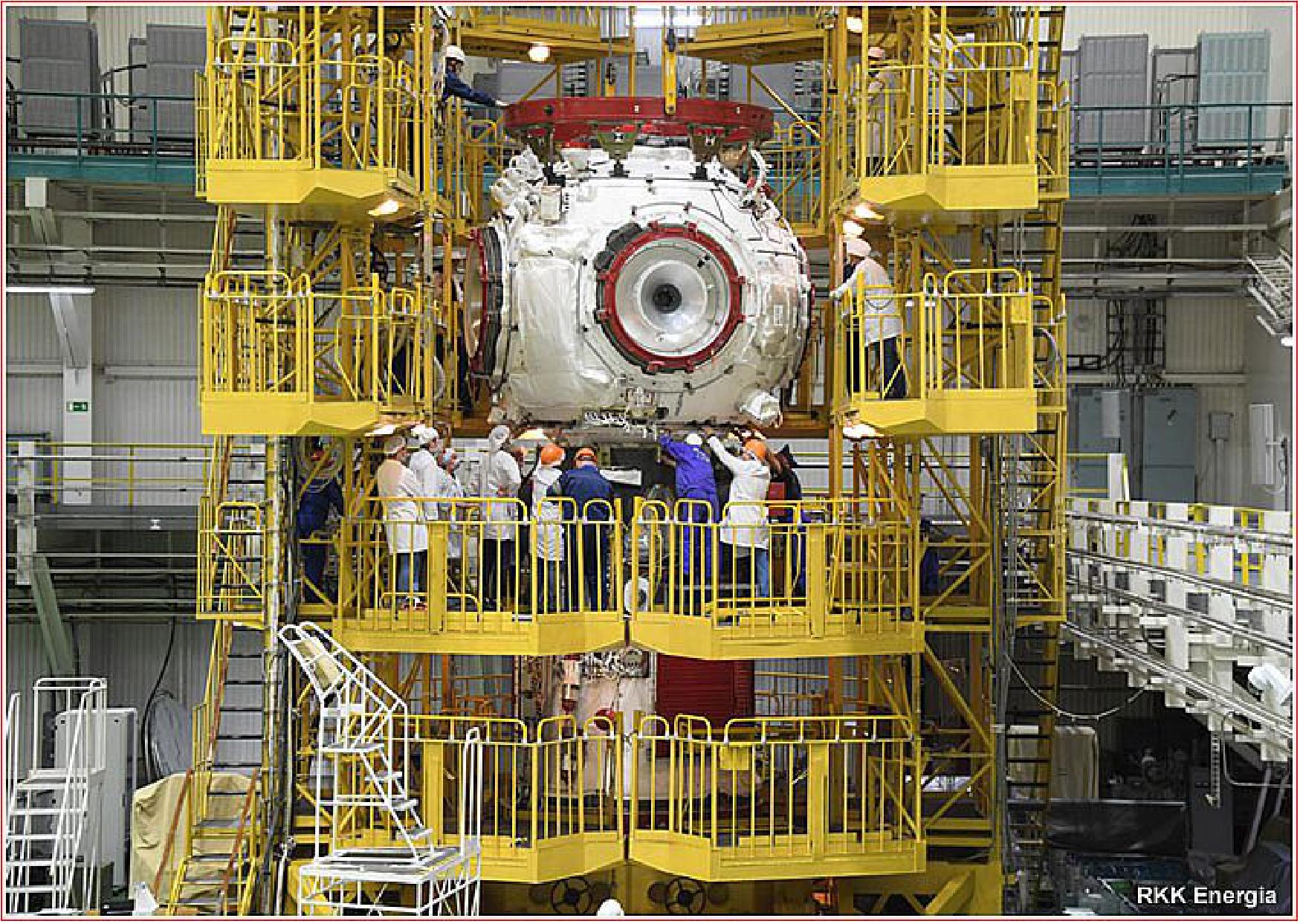
Launch Preparations
• November 22, 2021: The International Space Station is gearing up for a new Russian docking module due to arrive on Friday. In the meantime, the Expedition 66 residents focused on a variety of human research and space physics aboard the orbital lab today. 2)
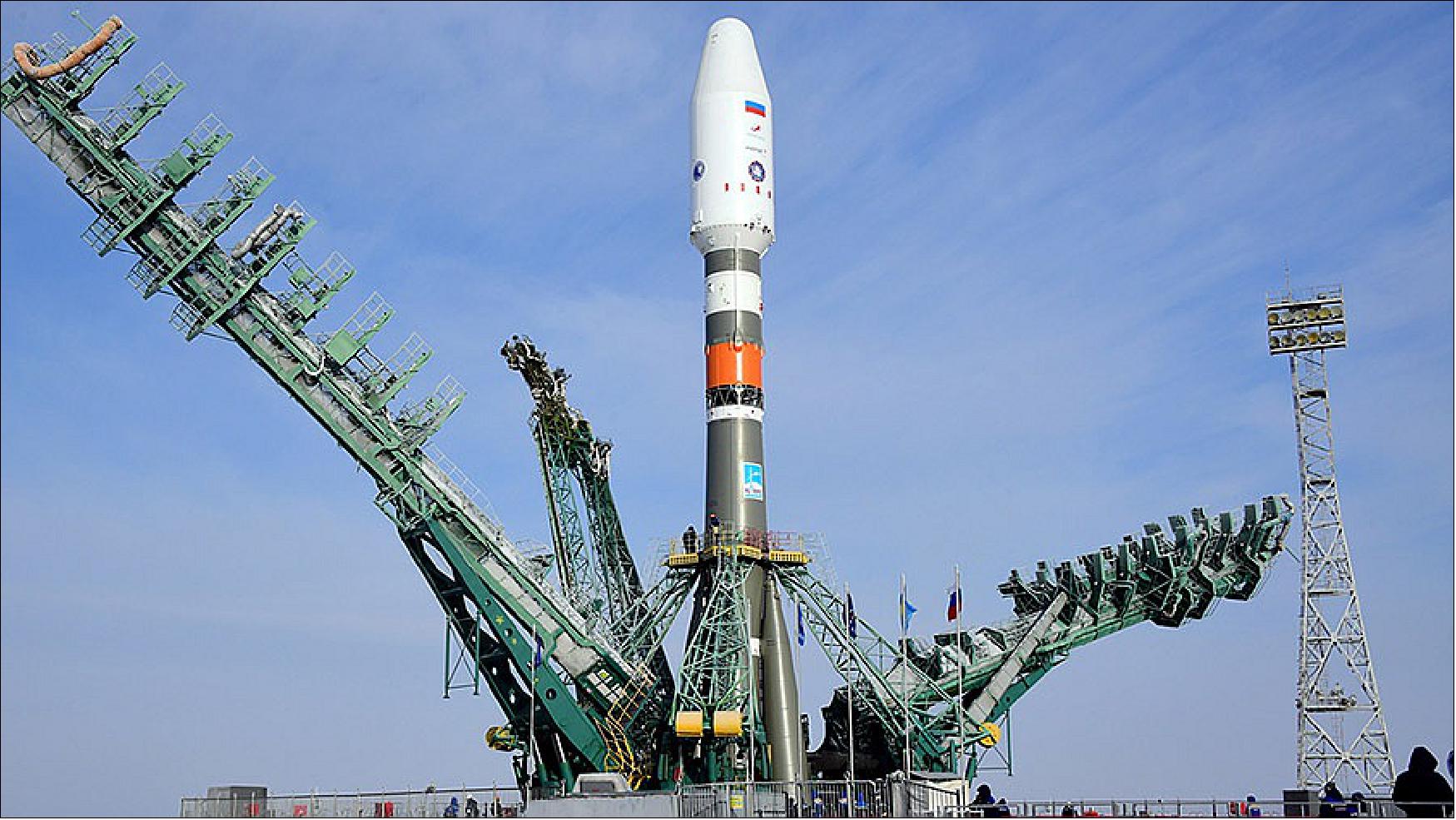
- Russia’s newest docking port, the Prichal module, sits atop a rocket at the Baikonur Cosmodrome in Kazakhstan counting down to a launch on Wednesday at 8:06 a.m. EST. It will arrive at the station on Friday (26 November) where it will automatically dock to the Nauka multipurpose laboratory module at 10:26 a.m.
- Cosmonauts Anton Shkaplerov and Pyotr Dubrov started Monday morning training for Prichal’s arrival. The duo from Roscosmos simulated the Russian docking port’s approach, rendezvous and docking on the tele-robotically operated rendezvous unit, or TORU. The TORU, located inside the Zvezda service module, can also be used to manually control and dock an approaching Russian spacecraft if necessary.
- Human research continued on Monday as NASA Flight Engineers Raja Chari and Kayla Barron studied how the central nervous system adapts to microgravity. The astronauts took turns wearing a virtual reality headset while seated inside the Columbus laboratory module for the GRASP experiment. The study observes a crew member reaching for virtual objects to compare hand-eye coordination and vestibular changes before, during, and after a spaceflight mission.
- NASA Flight Engineer Mark Vande Hei worked on a pair of space physics experiments throughout Monday. Vande Hei first serviced samples inside the Electrostatic Levitation Furnace which enables the safe research of thermophysical properties of high temperature materials in weightlessness. Next, he opened up the Microgravity Science Glovebox and uninstalled hardware supporting research that observes processes involved in semiconductor crystal growth.
- Flight Engineers Thomas Marshburn and Matthias Maurer worked throughout the day on a variety of robotics and maintenance activities. Marshburn worked on orbital plumbing tasks, collected station water samples for analysis, and took a robotics test for the Behavioral Core Measures study. Maurer partnered up with Chari practicing Canadarm2 robotic arm maneuvers planned for a spacewalk scheduled on Sept. 30th.
Launch
Russia's newest docking port, the Prichal module,launched on 24 November 2021 for the Russian Segment of International Space Station. It is much smaller (4 metric tons) than the 20 ton Nauka module launched in August 2021, but will add to the capabilities of the Russian segment by adding five docking ports where other spacecraft can park. 3)
Prichal, named for the Russian word for port or berth, has five available docking ports to accommodate multiple Russian spacecraft and provide fuel transfer capability to the Nauka module. Russia refers to it as either Prichal Node Module (UM) or Progress M-UM.
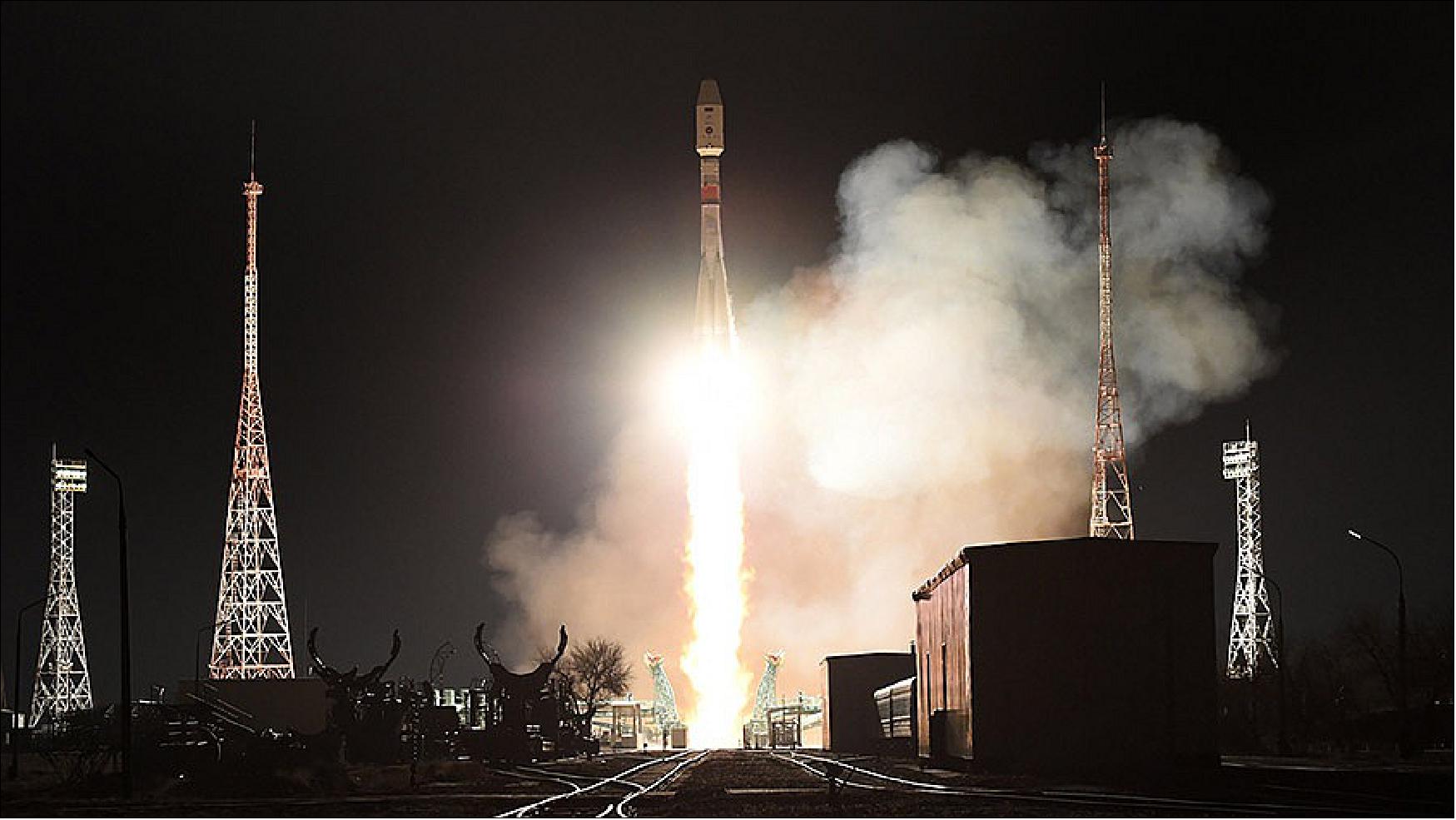
The new module, controlled by the Progress vehicle, will automatically dock to the Nauka multipurpose laboratory module on Friday (26 Nov) at 10:26 a.m. EST. Once attached, Prichal will provide five additional docking ports and fuel transfer capability to the orbiting lab.
Roscosmos cosmonauts Anton Shkaplerov and Pyotr Dubrov will be on duty Friday monitoring Prichal’s arrival.

• November 26, 2021: The 4 ton Prichal docking module arrived at the International Space Station at 10:19 a.m. EST, propelled by a modified Russian Progress propulsion compartment. They docked to the Nauka module on the Earth-facing side of the Russian segment two days after lifting off from the Baikonur Cosmodrome in Kazakhstan Wednesday, Nov. 24 at 8:06 a.m. EST (6:06 p.m. Baikonur time). The spacecraft were flying about 260 miles (421 km) over Ukraine at the time of docking. 4)
- To make room for Prichal, the uncrewed Progress 78 cargo craft undocked from Nauka at 6:23 a.m. Thursday, Nov. 25, and burned up upon reentry in the Earth’s atmosphere later that morning.
- Prichal, named for the Russian word for pier, has five available docking ports to accommodate multiple Russian spacecraft and provide fuel transfer capability to the Nauka module. Named for the Russian word for “science,” Nauka launched to the space station in July.
- The modified Progress transport spacecraft that guided Prichal to the station will remain in place until late December.
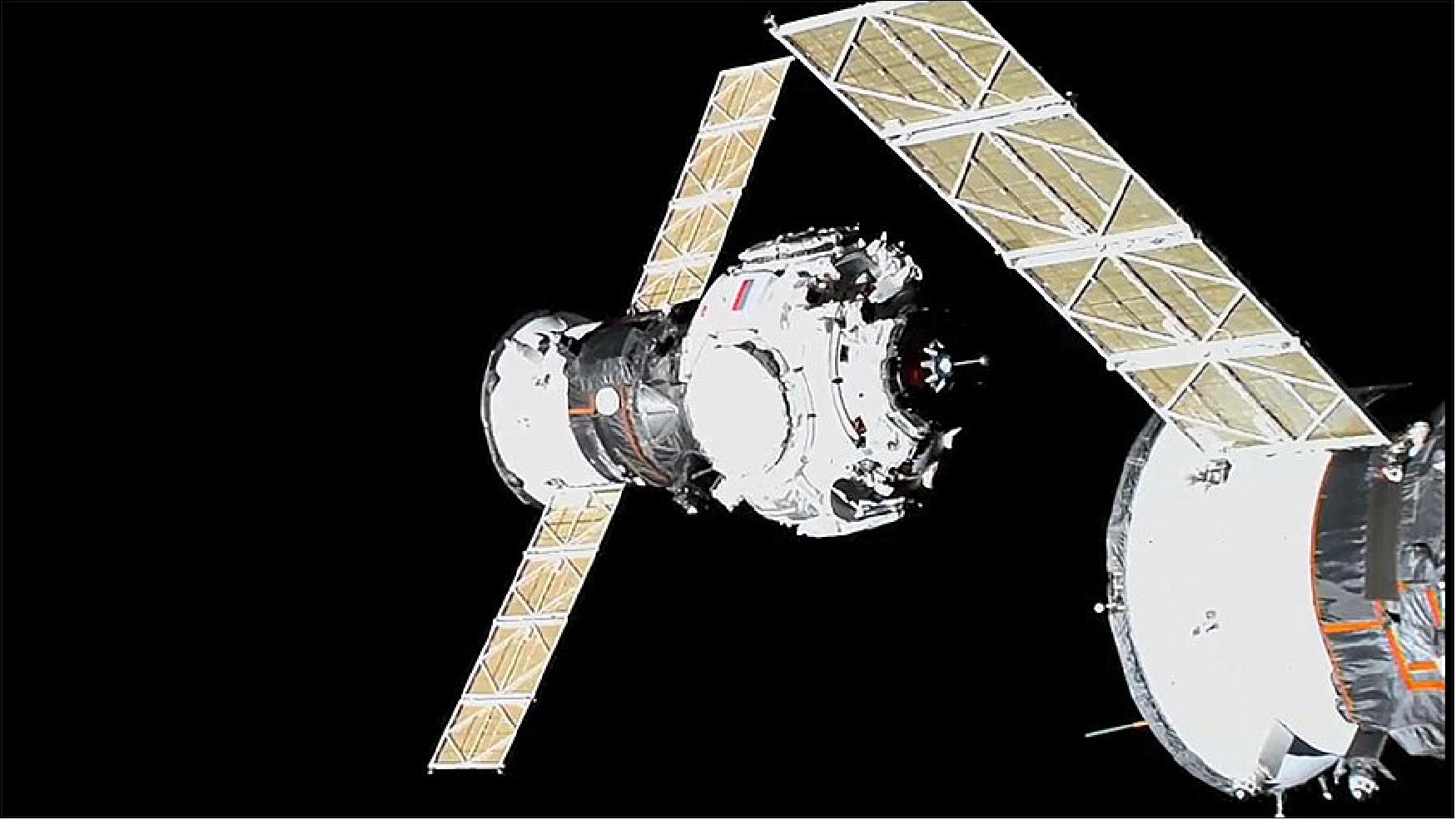
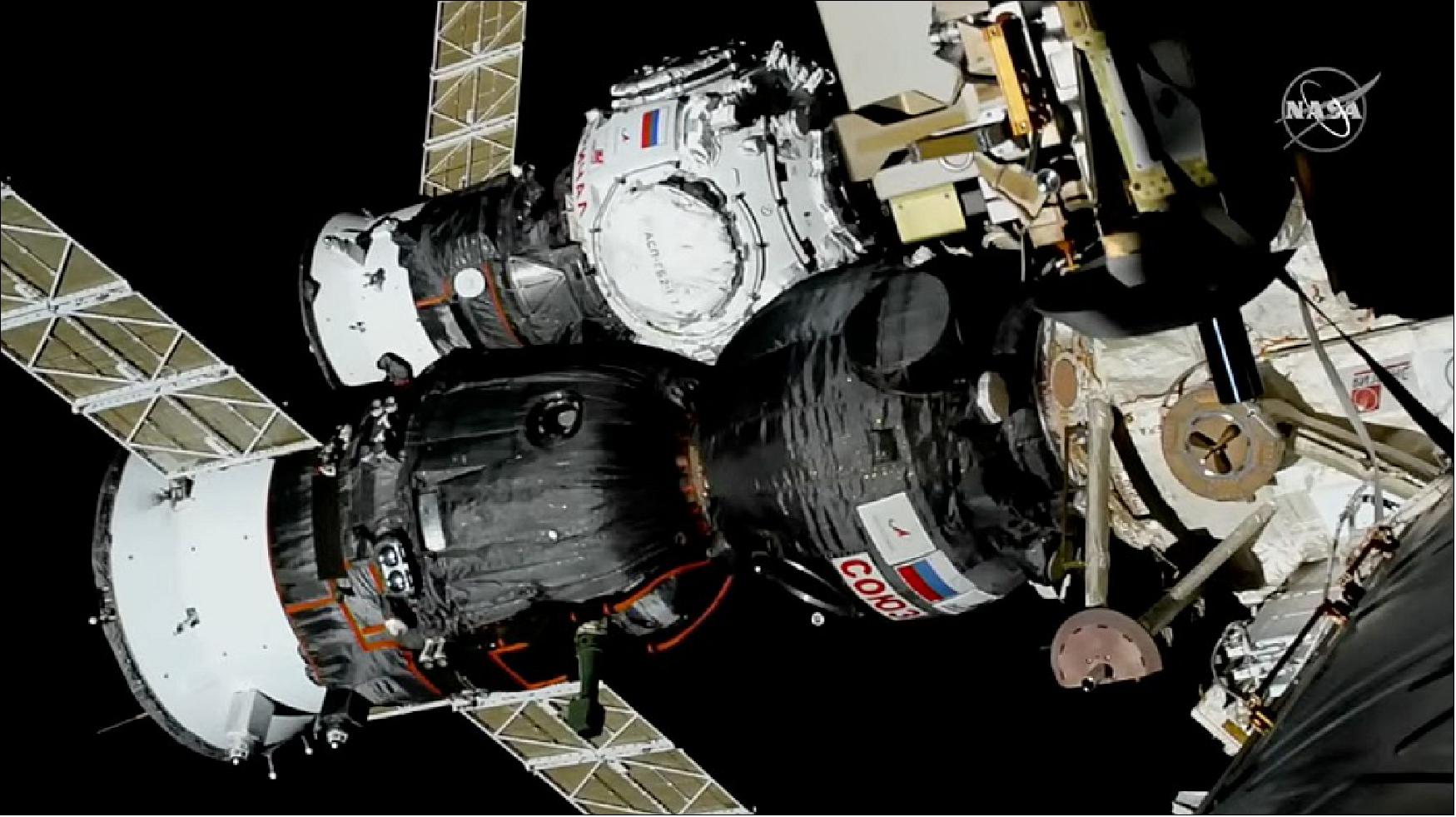
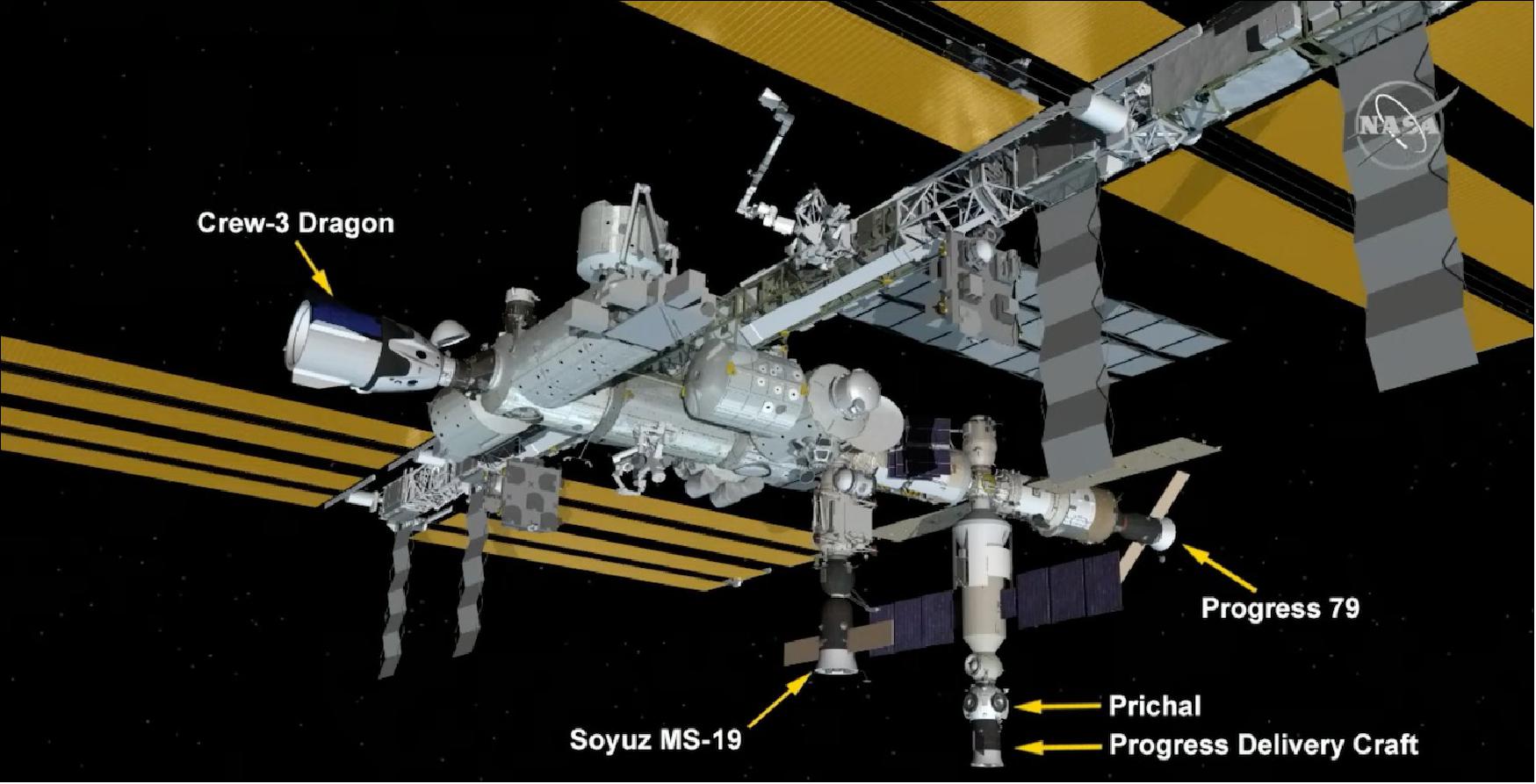
References
1) Anatoly Zak, ”Prichal Node Module, UM,” Russian Space Web.com, November 18, 2021, URL: http://russianspaceweb.com/iss_node.html
2) Mark Garcia, ”Crew Awaits New Docking Module During Human Research and Space Physics,” NASA Space Station, 22 November 2021, URL: https://blogs.nasa.gov/spacestation/
3) Mark Garcia, ”New Module Heads to Station During Spacewalk Preps and Science Today,” NASA Space Station, 24 November 2021, URL: https://blogs.nasa.gov/spacestation/2021/
11/24/new-module-heads-to-station-during-spacewalk-preps-and-science-today/
4) Mark Garcia, ”Russia’s New Docking Module Arrives at Station,” NASA Space Station, 26 November 2021, URL: https://blogs.nasa.gov/spacestation/2021/11/26/russias-new-docking-module-arrives-at-station/
The information compiled and edited in this article was provided by Herbert J. Kramer from his documentation of: ”Observation of the Earth and Its Environment: Survey of Missions and Sensors” (Springer Verlag) as well as many other sources after the publication of the 4th edition in 2002. - Comments and corrections to this article are always welcome for further updates (eoportal@symbios.space).